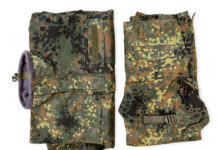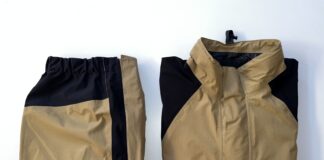The Carl-Cranz-Gesellschaft (CCG) recently organized a seminar on small arms ballistics in Vienna. The Weapons Technology Department of the Army Logistics School of the
In the seminar “Ballistics of small arms – focus on precision weapons”, specialist lectures were held over four days under the scientific direction of Armin Zotter, an internationally active expert in ballistics. The lecturers covered a wide range of topics, from an introduction to the basics of internal ballistics to wound ballistics in forensic medicine.
 In his opening keynote speech, Armin Zotter sums up what ballistics is all about: “The bullet flies out of the barrel and – in the best case scenario – hits the target. But for this to happen, a number of things have to fit together.” Powder grain geometry, powder burn-off and the maximum pressure adjustment of a load must be right, as well as many other factors. It quickly becomes clear that this is not a reloading seminar for amateurs. That’s a good thing!
In his opening keynote speech, Armin Zotter sums up what ballistics is all about: “The bullet flies out of the barrel and – in the best case scenario – hits the target. But for this to happen, a number of things have to fit together.” Powder grain geometry, powder burn-off and the maximum pressure adjustment of a load must be right, as well as many other factors. It quickly becomes clear that this is not a reloading seminar for amateurs. That’s a good thing!
All of the other speakers also led through the seminar program with professional expertise. Friedrich Leupold discussed the aerodynamic forces acting on the projectile by comparing model calculations and measurements of actual real shots.
Robert Hruschka, research associate at the Franco-German Research Institute ISL, then shed light on the difficult – and contradictory – study situation on the question of whether silencers improve or worsen precision. One result on the question that the participants were able to take home with them is that an individual measurement provides the best information.
In the second part of the lecture, Hruschka dealt with the ballistics of various arrow projectiles, the flechettes. He found a suitable option for ballistic drone defense for some types of ammunition – with some limitations (-> Focus on drones at Militär Aktuell).
Glardon Matthieu from the Institute of Forensic Medicine in Bern gave a presentation entitled “Evaluating current use of firearms in Switzerland”, which was the first seminar to focus directly on crime scenes where firearms were used. Glardon first introduced the – non-uniform – regulations on the use of firearms by police officers in Switzerland and then discussed the complex reconstruction of shots fired in premises using original data, among other things. A simple staircase becomes a complex crime scene when shots are fired.
It also became clear from the presentation that the effectiveness of shots fired depends not only on the type of ammunition used, but also on the course of the wound channel in the specific case and the mental state of the person.
The presentation “7.62 millimeters – one diameter, many calibers” by ammunition expert Bernd Krause brought the audience back into the world of ballistic calculations. Theoretical considerations were used to compare the external ballistics of the three known calibers 300 AAC Blackout, 308 Win and 300 Win Mag when using the same bullet in order to demonstrate the wealth of variants of the caliber diameter.
The topic of the presentation by Andreas Nehme, Managing Director of Nehme Waffentechnik GbR, was highly topical. In “Patterns and lightweight series parts additively manufactured”, Nehme went into the 3D printing basics and possibilities in weapon construction. Complex and stable designs can be produced if the right material qualities are taken into account. He presented examples from the areas of silencer and spare parts production. Knife parts, such as the 3D-printed titanium handles from Ug Tools (-> Here in the product test and hereSpecial solution from Ug Tools for government customers) are also included.
The second day of the seminar ended with a visit to a special exhibition at the Museum of Military History. There were historical weapons on display, including rarities such as a double barrel M1768 in 14.8 millimeter caliber, the German Wehrmacht’s Fallschirmjägergewehr 42 paratrooper rifle and Colt 1911 with magazines that were used after the Second World War.Second World War found in hiding places all over Austria after the Second World War. The Welrod repeating pistol with integrated silencer provided a “James Bond feeling”. From more recent wars, in this case from the war in Yugoslavia, a sniper repeating rifle in 50 BMG caliber with a powerful muzzle brake was on display (-> This is what a .50 caliber shot feels like).
On the following day, another special feature awaited the seminar participants. Numerous ballistic target media were fired at on the Exelberg shooting range. Under the guidance of the weapons technology teaching department of the Army Logistics School, hard and soft ballistic protective inserts and gelatine blocks were fired. The choice of calibers was special: from 5.7×28 or 5.45×18, fired from the PSM pocket pistol, the 7.5 FK, to 7.62×39 from Chinese production and numerous Holhspitz ammunition from authorities. The .50 BMG caliber was not to be missed either. In addition, various pepper sprays could be tried out.
There was also a lot to see. Loans from Austria Arms (
On the last day of the seminar, the presentations once again focused on detailed technical issues. Expert author Jochem Peelen looked at the characteristics of subsonic trajectories, i.e. projectiles that travel in the range of 310 to 370 meters per second. Combined with a silencer, they provide a tactical advantage, but this must be considered in relation to the effectiveness limit on ballistic vests and crosswind loads.
Theo Fischer illustrated the development and improvement of weapons and ammunition with military involvement. There are many differences between the civilian and military worlds, for example in the area of standards, which can be seen in terms of safety (civilian standard CIP) and functionality (military standard STANAG). The examples of the procurement of silencers – and the associated choice of the appropriate thread – as well as the different standards for mounting points of telescopic sights also make the complexity of the “procurement” aspect clear to outsiders.
Hermann Zwanzinger, a consultant at the Federal Ministry of the Interior (BMI), and Anton Eder demonstrated the changing requirements for police service weapons. Red dot sights on the pistol would offer numerous tactical advantages compared to steel or laser sights. The purchase of light modules would be no less important, as around 70 percent of weapons have been used in darkness or poor lighting conditions over the past 20 years. According to the speakers, failure to issue this additional equipment to the officers would inevitably lead to problems during operations.
The topic of weapon attachment also remained the focus of the presentation by Sebastian Lui, Product Manager at B&T. The first silencers were developed around 120 years ago. A lot has changed since then, not only in design but also in the manufacturing process. Additive manufacturing has opened up completely new possibilities for official and ultimately also civilian users. The development of temperature-resistant silencers is now actually possible.
In the last lecture of the seminar, Sarah Heinze, University Professor of Forensic Medicine at the Medical University of Graz, gave an impression of what clinical forensic medicine can report on the course of a crime using imaging techniques. Current examples were also used to show what effect which ammunition can have on different types of tissue, how intermediate targets – such as bones – can lead to changes in wound ballistics and how difficult it can be for first responders to assess wounds.
The seminar was not only a real “hit” as a training opportunity. Networking and exchange were also very important. With excellent support from the Army Logistics Center Vienna, hardly anything was left to be desired.














































